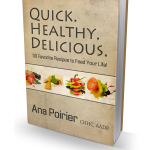 Many times when we start to incorporate more fresh produce into our diets, there is a learning curve regarding how much to buy and how to store it optimally. No body wants broccoli rotting in a back corner after 5 days!
Many times when we start to incorporate more fresh produce into our diets, there is a learning curve regarding how much to buy and how to store it optimally. No body wants broccoli rotting in a back corner after 5 days!
So, here are some quick and easy tips to maximize freshness and your dollars – less waste.
1) Buy as much as possible from your local farmer’s market where it has been picked that day. The majority of produce from local grocery stores is weeks old when you finally buy it.
2) To extend the life of your produce, store it in Green Bags (Ever Fresh at http://www.evertfresh.com/ or Debbie Meyer at https://www.greenbags.com/?cid=587724 or www.hsn.com) or use the new E.G.G. (Ethylene Gas Guardian, found at http://www.4theegg.com/).
3) Store as much as possible in your “crisper”.
4) Try wrapping the ends of greens with wet clothes or organic paper towels. This seems to help them last longer and keeps them from wilting.
5) To save time and plastic, take your green bags to the market with you. Then everything is ready to be stored upon arrival.
6)Mushrooms, jicama and Jerusalem artichokes (sunchokes) should be store in paper bags to prevent them from molding.
7) Tomatoes should be kept at room temperature.
8) Potatoes and onions should be stored in a cool, dark, dry environment. Not in the refrigerator.
9) Avocados should stay at room temperature until they ripen, then refrigerate.
10) Items like apples and oranges can be left out in a basket, but will last longer in the fridge.
11) Berries will do best refriderated in a container that allows some airflow.
12) Asparagus will stay freshest if you put the ends in water and cover them with a bag. Use as soon as possible.
13) Fresh herbs should be used within a few days. To store them longer, try processing in the food processor with a little olive oil. Divide into ice trays, freeze, then store the single portion doses in the freezer in baggies or glass containers.
Now, happy produce shopping!










